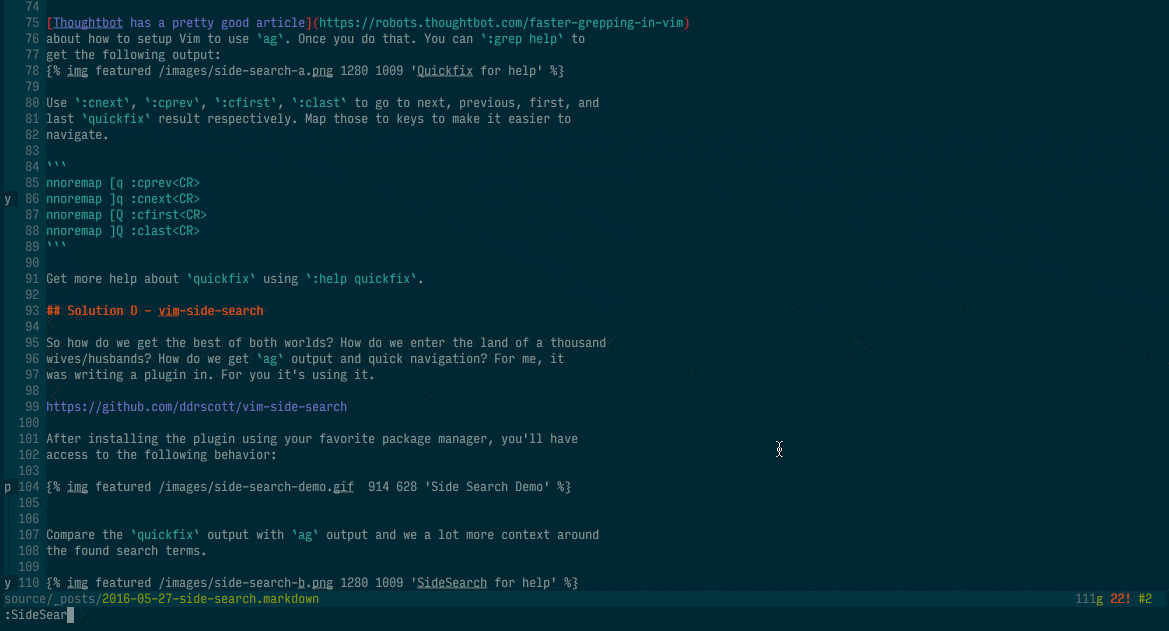Vim Side Search: Making Search Fun Again¶

The quickfix feature is nice, but it doesn't give enough context around the
search term that leads to use ag from terminal and switch back and forth
between programs. I do this search dance every day and I've had it! There must
be better way!
Problem¶
 Look at the
Look at the quickfix window above. It spends most of its space showing the file name
of the hit, then the remainder is spent on text around it. In projects using
Rails Engines with deeply nested
directory structures, this often leaves me with just a bunch of paths in the quickfix.
Solution A - The Unix Way¶
Some may argue Vim isn't suppose to do search. Vim rightly delegates to the
Unix philosophy by
allowing an external program do its searching. Let's try that for this
solution using grep, ack, and ag.

We've run the 3 separate programs (normally, I would only use ag) then
browse the results to see if there's an interesting file. At this point I start
using my handy-dandy mouse to scroll around, precisely highlight the path of
interest, copy, and type vim <Paste>. Intuitive? Yes. Fast? No!
Maybe I should use tmux or screen so I don't need to mouse around, but
trying to select a path is still pretty slow for me and requires more cognitive
load than I have patience for. After all, I'm trying to concentrate on a
refactor or something, not how to open a bunch of files. Should I practice more?
Yes. Will I? No!
We're going to use ag from now on, since it's faster than ack, and has
prettier output than grep. I really really really tried to get grep to
output for humans, but couldn't figure it out.
Solution B - Vim without Quickfix¶
Let Vim do some work for us.
vim `ag --ignore=\*.{css,scss} -l help` +'/help'
What's that?!? Open Vim passing the result of ag command. ag is run with
some file exclusions, -l only file names, and help is the search term.
+'/help' tells Vim to immediately start searching for 'help'.
After all that, Vim should have started with a bunch of buffers. View them with
:ls. Take notice of the buffer numbers to see how many files were found. Use
n and N to jump through search matches in the file. Use :bn to go to the
next buffer and start hitting n again to cycle through the changes. If the
number of files is small enough, you may be able to use :ball to open every
buffer in its own window.
Thats a lot of work to jump through changes. Good thing the quickfix exists.
Solution C - Quickfix¶
This is here for posterity. quickfix DOES make cycling through changes easier
than Solution B, but as I stated in the intro, it doesn't give the context that
we want.
Thoughtbot has a pretty good article
about how to setup Vim to use ag. Once you do that, you can :grep help to
get the following output:

Use :cnext, :cprev, :cfirst, :clast to go to next, previous, first, and
last quickfix result respectively. Map those to keys to make it easier to
navigate.
nnoremap [q :cprev<CR>
nnoremap ]q :cnext<CR>
nnoremap [Q :cfirst<CR>
nnoremap ]Q :clast<CR>
Get more help about quickfix using :help quickfix. Cry after realizing
even :help quickfix can't show more context. I'll be here when you're done.
Solution D - Side Search Plugin¶
So how do we get the best of both worlds? How do we enter the land of a thousand
wives/husbands? How do we get ag output and quick navigation? For me, it
was writing a plugin in. For you it's using it. https://github.com/ddrscott/vim-side-search
After installing the plugin using your favorite package manager, you'll have access to the following functionality:

Things to notice:
agoutput is in a buffer with additional syntax highlighting!nandNused to jump to matches. Regular Vim navigation works, too!<CR>and<C-w><CR>used to open change and jump to change!- Number of matches shown in the buffer name!
- I use too many exclamation points!!!
The plugin's README has more details.
Closing¶
I've been using this plugin ever since its inception and don't know where I'd
be without it. It gets some inspiration from fugitive's
:Gstatus mode/buffer, and I wish there were more plugins that added
functionality from stdout instead of transforming it into a different format. Unix
tools makers spend a lot of time thinking about the output. Let's use it to our
advantage.
I've learn a lot creating this plugin and plan to write about it in a future post. Do you love it or hate it? Have more ideas for Side Search? Please let me know what you think of it. Have more ideas or issues for Side Search? Hit me up on Github.
References¶
- The Silver Searcher by Geoff Greer
man agman grepman tmuxman screen:help quickfix- Faster Grepping in Vim by Thoughtbot
- The number 12